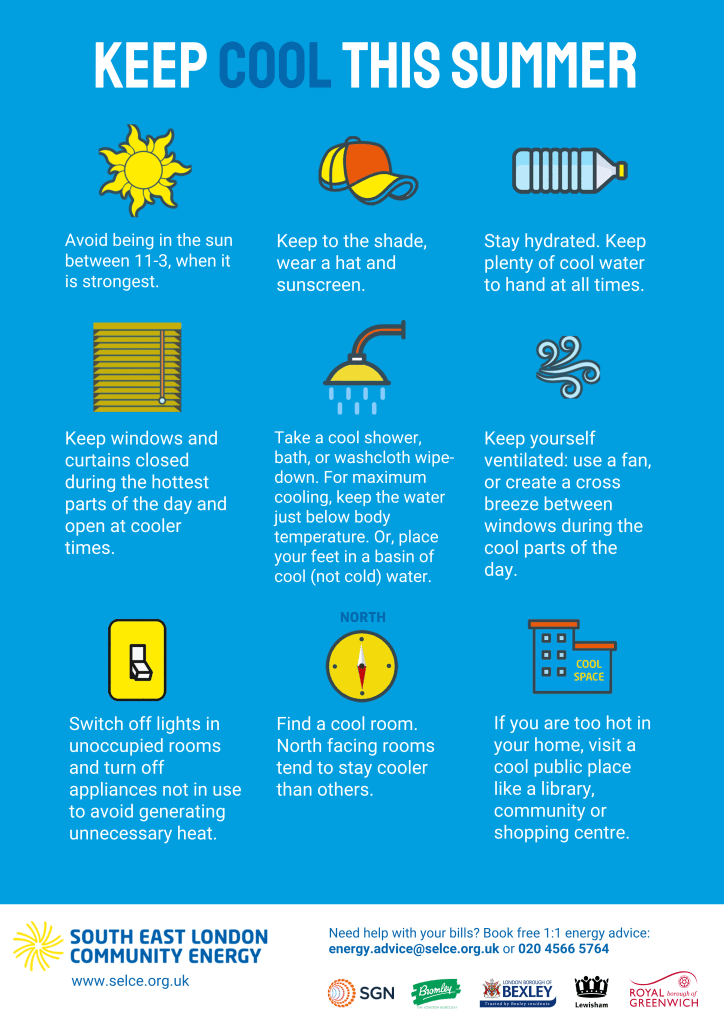How to Keep Cool This Summer
While it’s crucial to keep warm during the winter, it is just as important to keep cool in the summer. We’re moving in to a potentially hot and dry summer, and there are lots of things that you can do to keep cool:

1. Avoid being in the sun between 11-3, when it is strongest.
2. Keep to the shade, wear a hat and sunscreen.
3. Stay hydrated. Keep plenty of cool water to hand at all times.
4. Keep windows and curtains closed during the hottest parts of the day and open at cooler times.
5. Take a cool shower, bath, or washcloth wipe-down. For maximum cooling, keep the water just below body temperature. Or, place your feet in a basin of cool (not cold) water.
6. Keep yourself ventilated: use a fan, or create a cross breeze between windows during the cool parts of the day.
7. Switch off lights in unoccupied rooms and turn off appliances not in use to avoid generating unnecessary heat.
8. Find a cool room. North facing rooms tend to stay cooler than others.
9. If you are too hot in your home, visit a cool public place like a library, community or shopping centre.
Things You Can Install
UV window film
- Can cut summer cooling utility bills by 30-40%
- Blocks 99% of UV rays, protecting furnishings from fading
- Check your windows’ warranty
Loft Insulation
Loft insulation – as well as keeping in 25% extra heat at home, also reduces the amount of heat that comes in during the warmer months. You can find out about government funding for retrofit on our dedicated page.
Air Conditioning
If you need to go down this route, check the device’s energy performance certificate to see how much it will cost to run, and how efficient it is.
Guide to Home Temperatures
24°C – very warm, could be unsafe for heart conditions
18-21°C – comfortable temperature
18°C – minimum for being comfortable
12-16°C – fairly cold, could be unsafe for respiratory conditions
12°C – cold, could be unsafe for heart conditions
Signs of heat exhaustion
The signs of heat exhaustion include:
- tiredness
- dizziness
- headache
- feeling sick or being sick
- excessive sweating and skin becoming pale and clammy or getting a heat rash, but a change in skin colour can be harder to see on brown and black skin
- cramps in the arms, legs and stomach
- fast breathing or heartbeat
- a high temperature
- being very thirsty
- weakness
The symptoms of heat exhaustion are often the same in adults and children, although children may become irritable too. If someone is showing signs of heat exhaustion they need to be cooled down and given fluids.
What should I do if I see someone with heat exhaustion?
If they can be cooled down within half an hour, then heat exhaustion is not normally serious.
NHS advice says:
- Move them to a cool place.
- Get them to lie down and raise their feet slightly
- Get them to drink plenty of water – sports or rehydration drinks are also OK
- Cool their skin – spray or sponge them with cool water and fan them. Cold packs around the armpits or neck are good too
However, if they do not recover within 30 minutes, then what follows is heat stroke.
It is a medical emergency and you should call 999.
People with heat stroke may stop sweating even though they are too hot. Their temperature could go over 40C and they might have seizures or lose consciousness.
